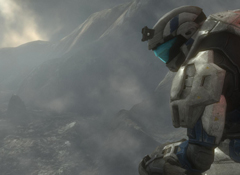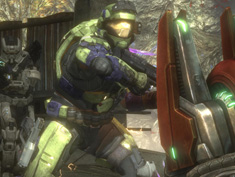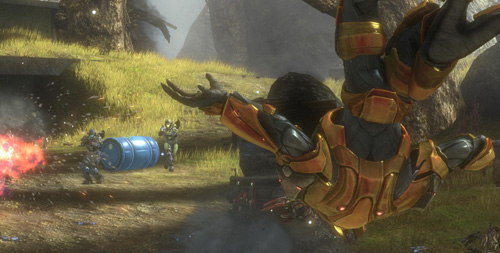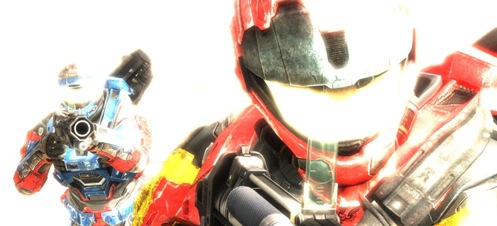 Whether we like it or not, Halo is a game that changed the FPS landscape forever. It can be argued that this is for both good and ill, but the fact remains that the epic FPS sci-fi series from Bungie typically constitutes a natural disaster in whatever year it arrives. Halo: Reach has made landfall, gentlemen, and it’s time to sort out the damage.
Whether we like it or not, Halo is a game that changed the FPS landscape forever. It can be argued that this is for both good and ill, but the fact remains that the epic FPS sci-fi series from Bungie typically constitutes a natural disaster in whatever year it arrives. Halo: Reach has made landfall, gentlemen, and it’s time to sort out the damage.
After a couple weeks of reading other Halo: Reach reviews, there seems to be a general consensus. One, that writers like to use the phrase “swan song”. Two, that Bungie’s final installment into the Halo series culminates in what might be its greatest and most critically acclaimed title yet. Reviewing a Halo game carries with it a tricky balance of managing hype, expectations and fanboy glee, but in Reach, it’s hard to ignore all of the wonderful things that Bungie accomplished, and how they’ve changed the game yet again moving forward.
So, just how good is the game? Read on to find out.
For longtime fans of the Halo series, the planet of Reach has been the linchpin of the Halo mythology. As the last bastion of human defense before the Covenant reaches Earth in its systematic galactic elimination of mankind, it’s the Titanic of our outposts that must not be sunk. Anyone familiar with Halo’s immense lore knows that the fall and glassing of Reach is what started the whirlwind of events that is the Halo series proper, with Master Chief and company jumping out of the battle over the planet straight to the Halo containment facilities. With that knowledge of the sad story of Reach, many Halo fans enter into this prequel not expecting a happy ending; it’s the battle we’ve been waiting to see.
So it’s good for us, then, that the game looks so gorgeous. I’ll go ahead and get this out of the way: Halo games have never been particularly striking in terms of their graphics. In my opinion, each and every game looked almost dated visually for that year of its release. That being said, the art direction of Halo has always been its shining achievement in terms of aesthetics.
The thing about Halo: Reach, is that it has both the graphical chops and the art direction to make it one of the more impressive looking games I’ve seen, particularly in its landscapes and huge environments. Nearly every vista is stunning, and is a far cry from some of the monotonous areas the game has been criticized for in its history.
The game opens with several scenes that hand the reins from Master Chief over to Noble Six, the newest member of Noble Team, a badass group of Spartan III soldiers (with one Spartan II in the form of the behemoth gatling-gun wielding Jorge) that first discover the Covenant presence on Reach while investigating possible rebel activities. Following a group of characters is something relatively new to Bungie, and just like in ODST, they shift the focus from an invincible anonymous soldier to a team of tight-knit warriors ready for anything. As I’ve said before, it’s no secret that humans lose the battle of Reach and Master Chief is the last active Spartan after its bitter end. Part of the joy of Reach is gradually coming to connect with each of these Spartans, and the way some of them give their lives for the struggle against a seemingly immutable enemy. For me, it was the first Halo game that made me care about the cast. In a series that has always had weak and vanilla characters, this was a huge bonus. Onto the gameplay.
Obviously, Noble Team discovers that the rebel activity isn’t really caused by rebels, but alien invaders hellbent on discovering their secrets and then destroying them. From the opening salvos of plasma rifle fire, one of Reach’s shining features becomes clear. Halo: Reach is the hardest Halo game yet, and in a totally good and non-frustrating way. Gone are the endless streams of boring Brute encounters, and back are the shift Elites, hard to fight and even harder to kill. Seriously, whenever an Elite shows up, it’s like taking down another human player, just as crafty and skillful as you and even faster and stronger. The AI of the enemies makes for an incredibly fun campaign, particularly as the difficulty notches up with each and every level.
 Speaking of the different missions, Halo: Reach features several which constitute some of my favorite Halo missions ever. For fans of the wide open encounters experienced in Halo: CE’s Assault on the Control Room as well as the Scarab showdowns in Halo 3, Halo: Reach is the game that finally has the scale that we’ve been waiting to see, mission after excellent mission. In addition, Reach doesn’t have any of those infamous backtracking and endless affairs such as Cortana or The Library. There is no single mission that sticks out in a negative way.
Speaking of the different missions, Halo: Reach features several which constitute some of my favorite Halo missions ever. For fans of the wide open encounters experienced in Halo: CE’s Assault on the Control Room as well as the Scarab showdowns in Halo 3, Halo: Reach is the game that finally has the scale that we’ve been waiting to see, mission after excellent mission. In addition, Reach doesn’t have any of those infamous backtracking and endless affairs such as Cortana or The Library. There is no single mission that sticks out in a negative way.
In fact, Bungie found excellent ways to vary up the game play in subtle yet significant shifts. On top of the epic and huge vehicle battlefields, the game takes you to space, platforming with jetpacks through a ravaged city, and flying across rooftops in a series of helicopter combat skirmishes. It even takes the conventional “escape” final mission and turns it entirely on its head, giving you something you wouldn’t quite expect while still satisfying those who have come to expect it.
My favorite point of the game revolved around defending a series of turrets from increasingly difficult waves of Covenant forces, racing back and forth between each one with a mongoose. Each mission is excellently paced and designed, and the “30 seconds of fun” gameplay mechanic in repetition is given slight jolts throughout to keep it fresh and different. Yes, this game still plays like Halo. But for the first time it truly feels like the combat is evolved.
As the campaign draws to a close, there are definitely going to be some mixed reactions. Without going too much into spoiler territory, I will say that Bungie ousted some of the canon they’ve come to establish over the last decade through Eric Nylund’s books. However, these changes ultimately serve the game and present a really circular conclusion to the series, so it’s hard to fault the studio for doing this. While the inner fanboy in me was disappointed at this turn of events, I can’t argue with how strongly the game ended. In fact, within a few minutes of the game’s final and emotional stage, I made sure to tell my co-op buddies that this was my favorite Halo campaign yet, and that’s saying something.
Which brings me to the multiplayer portion of the game. As with Halo 3 and ODST, 4 players can play through the game simultaneously. This becomes even more fun with scoring for teams or individually, as well as skulls that up the difficulty level. On top of all of that, Halo: Reach actually scales in difficulty depending on how many players are in your party. While Halo 3 was fun with multiple campaign soldiers, it grew exponentially easier with each and every one that joined. Halo: Reach was difficult in its later stages even on Heroic with 4 players, and I’ve already started up the Legendary campaign as well. Co-operative is simply a blast to play, and I really think it’s one of the best ways to experience Reach to get its full effect.
And for those of you who are dying for even more co-operative play, Bungie has brought back Firefight from ODST. This time, however, the game is different in that you can customize it with the same level of detail as you can for the traditional multiplayer modes. Want to square off against only grunts in Gruntpocalypse? Sure. Want waves of nothing but sword wielding elites while you have unlimited jetpacks and rockets? You can do that, too. Firefight is enormously fun and enormously big this go around, and no doubt has hours upon endless hours packed within its many modes of play.
As for multiplayer, it’s hard to elaborate any farther. You either love Halo’s multiplayer or you don’t. I for one have always been crazy about Halo’s multiplayer, even though it’s always been missing something to me since Halo: CE. To me, Reach’s multiplayer improves upon so many aspects of Halo 3’s multiplayer that it’s ridiculous. The game feels extraordinarily balanced, and for a release really only needs a few tweaks. The pistol is back and packs a great punch, and dual-wielding has been eliminated from the game’s vocabulary as well. Armor abilities mix up the gameplay without breaking it or making it feel un-Halo. Without even harping on how the game plays, there are also credits to unlock and customizable armor upgrades, so that any player can distinguish himself from the pack.
The only real downside to Halo: Reach in terms of multiplayer would have to be its levels. I thought Halo 3’s levels were the best of the entire bunch, so to step down to the plain levels of Halo: Reach is quite disappointing. The environments are almost bland in comparison, and while including the Forge World Halo re-creation maps as part of this game, having them make up a quarter of its map content feels like a letdown, especially considering each one looks the same. That being said, the gameplay works so well that it’s hard to notice, and it’s nothing that can’t be changed with a few inevitable DLC map packs.
Phew. As long as this review is, I think I’ve probably left out a few things. The fact that every single gametype contributes to your credit score is inspired, and gives extra incentive to sample things you might not have before. The daily and weekly challenges dangle a carrot in front of you constantly to keep playing multiplayer and firefight. The Theater and Forge modes are back and better than ever, which are going to allow for some crazy gametypes and maps in the coming months. In fact, all of the images in this review were taken from Theater mode, of games played from GamerSushi contributors Mitch, Nick and Anthony.
So, with all of that being said, I can confidently say that Halo: Reach stands as my favorite Halo game in every single aspect. It’s the Halo game that I feel like I’ve been waiting for since the start of the series, and in many ways returned to the things that made Halo: CE so great. As I said before, it’s Halo perfected, come through the fire, and its an excellent way for Bungie to close out their monumental series: with a game that’s bigger and better than all of its predecessors. It deserves our coveted S rating not only from its sheer size of content, but also for the amount of care and polish displayed in every single piece of it. Take it from a professed Halo fanboy: Halo: Reach is the best Halo game yet, and will be remembered as a classic.
GamerSushi Score:

How does our grading system work? Check out our grade chart!




Totally agree with the review. And actually Eddy the inconsistencies with the canon are actually one of the big purposes of Dr. Halsey’s journal that came with the limited and legendary editions. For a explanation of the inconsistencies, check this out (SPOILERS): http://www.bungie.net/Forums/posts.aspx?postID=49028942&postRepeater1-p=1#49029966
Like SK Beans, I think its a great game. Although the plot just doesn’t fit out. I won’t try to spoil anything,but I just want to say although the ending wasn’t what I wanted. I suppose Bungie did that just to make the story line to fit. Speaking of which. The end credits with the Pillar of Auttumn looks awesome. Perhaps microsoft will do an hd remake of the halo series in reach engine to get some more money. Now knowing microsoft and their love of money. This may just happen. or not.
Great review, this is easily the best Halo game. It turned me into a fanboy within the first few hours.
Now excuse me, I gotta go play ODST, Halo Wars and read The Fall of Reach.
REMEMBER REACH!!!!!!!
I disagree with the S, mostly because the campaign didn’t really strike a cord with me. It couldn’t make me care about the characters enough. The online is definitely the best of the series though.
I have to say I’m surprised with the “S” score. I don’t understand how SC II didn’t get an S while this did… I believe that game was definitely better or on par with Reach. Then again, it’s the reviewers preference and they are two totally different games.
[quote comment=”13637″]I disagree with the S, mostly because the campaign didn’t really strike a cord with me. It couldn’t make me care about the characters enough. The online is definitely the best of the series though.[/quote]
I would submit that this is the first Halo game that does make you care about the characters, or at least tries to. The other games had cardboard cut outs compared to Noble Squad.
[quote comment=”13637″]I disagree with the S, mostly because the campaign didn’t really strike a cord with me. It couldn’t make me care about the characters enough. The online is definitely the best of the series though.[/quote]
I thought the campaign was excellent; the best of the series. While that isn’t saying much, I thought the overall story was quite engaging, and I appreciate it more for the set pieces than the narrative. While I do agree that the characters were a little shallow, Bungie did a good job in building them up in the short time they had. I think of Noble as a nice garnish on a tasty dish. Not the main course, but something that accentuates the flavor.
[quote comment=”13638″]I have to say I’m surprised with the “S” score. I don’t understand how SC II didn’t get an S while this did… I believe that game was definitely better or on par with Reach. Then again, it’s the reviewers preference and they are two totally different games.[/quote]
While, considering that I did the SCII review and Eddy did this one, I’d say that’s different strokes for different folks. Part of the reason I didn’t give StarCraft II an A was because I thought it was mostly the same as the first, just with a graphical update and a few tweaks. Halo: Reach is the culmination of a ten-year learning process. Blizzard had ten years as well to work on SCII, but it feels like they thought they didn’t need to try anything new with it. Just my opinion there. Although, Eddy did say that he would probably give SCII an S, so what do I know?
its off the bomb im a cool kid and my mom and dad let me play it